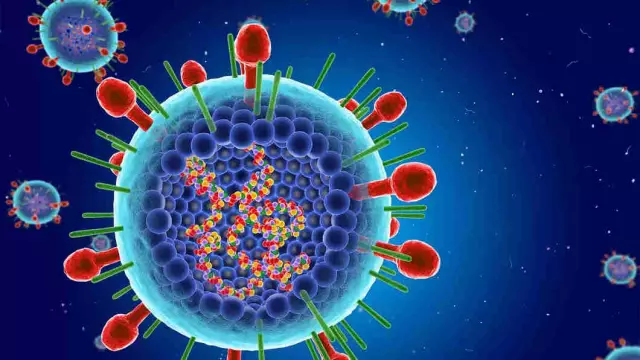- Author Rachel Wainwright [email protected].
- Public 2023-12-15 07:39.
- Last modified 2025-11-02 20:14.
Galactorrhea
Galactorrhea is the process of secretion of colostrum, milk or milky fluid from one or two mammary glands.

Galactorrhea is a natural condition during pregnancy and breastfeeding. If a woman has galactorrhea syndrome outside of pregnancy or continues for six months or more after stopping breastfeeding, this is a pathology. In galactorrhea syndrome, milk or colostrum secretion is characteristic as a result of touching or stimulating the breast. It happens that fluid is released for no apparent reason. The amount of secreted secretion can be either abundant or not.
It happens that galactorrhea also occurs in men, but in women this pathology is much more common.
The main causes of galactorrhea
Control of lactation in the body is carried out by the interaction of certain hormones, the production of which occurs in the pituitary gland and hypothalamus. Due to the violation of the processes of their production, this pathology develops. The most common causes of galactorrhea are:
- the presence of a tumor in the anterior pituitary gland (prolactinoma, somatotropinoma);
- violations of the regulatory effects of the hypothalamus on the pituitary gland;
- disruption of the thyroid gland (hypo- or hyperthyroidism);
- violation of the optimal ratio of the level of hormones in the body;
- pregnancy and the period of breastfeeding;
- hepatic or renal impairment;
- adrenal pathology (estrogen producing tumors, hypocorticism);
- Checking your breasts too often for tumors (every day or several times a day);
- the use of certain drugs that develop hormonal imbalance;
- ovarian pathology (polycystic, etc.);
- mastitis;
- pathological reflex activation (mechanical or sucking stimulation of the mammary glands);
- drug use (opiates, marijuana);
- wearing uncomfortable and too tight clothes;
- phytotherapy with drugs that affect the hormonal background of the body (fennel, anise, nettle).
If the exact cause of galactorrhea cannot be established, then it is called idiopathic.
Symptoms of galactorrhea
The main symptom of galactorrhea is menstrual irregularities. In this case, there is either a complete absence of menstruation, or their presence is very scarce and irregular. Galactorrhea syndrome can proceed without menstrual irregularities. In this case, the patient does not feel any changes in the body.
Violation of the menstrual cycle is accompanied, as a rule, by the occurrence of the following symptoms of galactorrhea: heaviness and swelling of the mammary glands, headache, dull pain in the breasts. Possible increased growth of chest hair, visual impairment. One of the symptoms of galactorrhea is acne. Decreased libido is possible. Due to the abundant secretion, eczema and skin maceration may develop.

The color of the discharge in galactorrhea is of great importance. So, the milky white color of the discharge, indicating the presence of casein and lactose, suggests that normal breast milk is excreted from the breast. However, if the color of the discharge is brown or greenish and is not similar in composition to breast milk, then this may indicate endocrinopathy. Reddish bloody discharge signals the presence of malignant tumors in the mammary gland.
Diagnosis of galactorrhea
Treatment of galactorrhea must be directed at eliminating its cause. Since the causes can be very different, often many studies are required to diagnose the disease.
Diagnostics begins with a general examination of the patient and a survey. This information can help in determining the cause of galactorrhea.
If a pituitary tumor is suspected, the patient is referred for a consultation with an ophthalmologist and a computed tomography scan is prescribed or an image is taken using magnetic resonance imaging. Also, to establish the cause of galactorrhea, it is necessary to examine the level of hormones in the blood, especially prolactin.
A complete examination includes an ultrasound of the liver, ovaries, kidneys, mammary glands and the main areas of the lymph nodes. If the reason cannot be found out, then additional types of research may be prescribed.
Galactorrhea treatment
First of all, when treating galactorrhea, it is necessary to eliminate the cause that caused the pathology. This, in fact, will help to reduce and even completely eliminate the symptoms of the disease. If the cause of galactorrhea cannot be found out, then drugs are prescribed that reduce the level of the hormone prolactin in the blood. Usually, with mild idiopathic galactorrhea, drugs are not prescribed, but a woman is recommended to bandage her chest with a bandage.
If a tumor is the cause, don't panic right away. Typically, these tumors are rarely cancerous and usually respond well to treatment. Depending on the specific case, medical or surgical treatment may be prescribed.
It happens that treatment for galactorrhea is not required at all, since it tends to self-cure. It is simply necessary to avoid breast stimulation for a certain period of time.
YouTube video related to the article:
The information is generalized and provided for informational purposes only. At the first sign of illness, see your doctor. Self-medication is hazardous to health!






